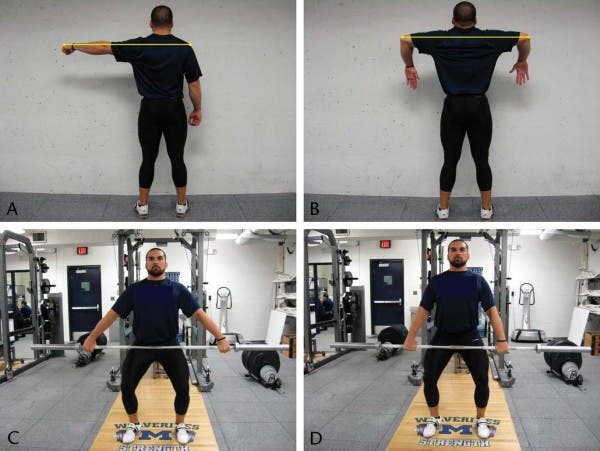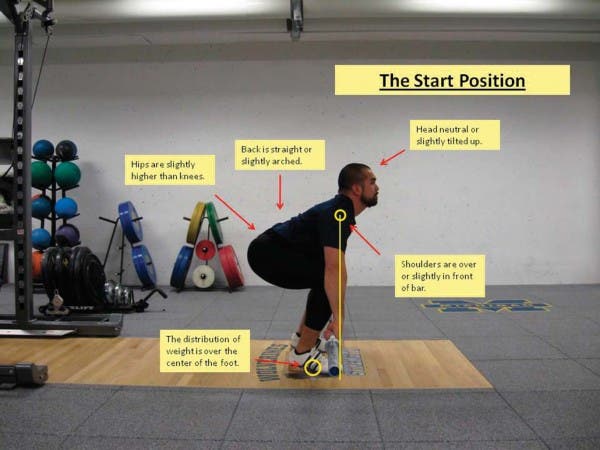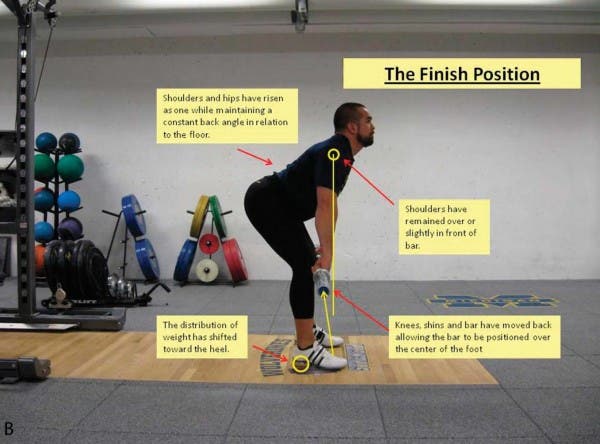The first pull is the initial movement phase in the clean and snatch exercise. It begins at the moment the bar is lifted off the ground and continues until the bar reaches the top of the knee, or in some people, just above the knees. There are several important reasons for teaching the correct execution of the first pull. First, proper mechanics during this movement places the body in an efficient biomechanical position, facilitating exercise. By reducing the mechanical disadvantage you will be able to execute the movement without expending more energy than necessary. Second, with proper technique, you will be able to establish an optimal center of gravity. Third and last, as it precedes the double knee flexion or transition phase, a correct execution of the first pull has a potentiating effect causing a strong stretching and improvement of the next concentric part, which in turn establishes the second pull. Since it is during the second pull that you push against the ground by extending the hips, knees, and ankles (known as triple extension), a smooth transition from the first to the second pull is vitally important. The success you can have in the clean and in the snatch will depend largely on the start, so that movement will be the one that requires the most effort in training. The first pull, therefore, is the phase that establishes all the correct biomechanical functioning of the exercise, as well as the most efficient movement to lift large weights safely. Unfortunately, many people do not prioritize this movement in the first months of training, which often leads to poor execution technique habits that will lead to injury and poor performance.
Starting position
The start or starting position will vary slightly depending on the type of lift (clean or snatch), flexibility, range of motion and other anthropometric variables (somatotype, height, weight, limb length, body mass, etc.) Establish a correct lifting position. starting is not as simple as bending down and picking up the bar; there are a number of key elements to consider. To begin, the lifter will be centered on the bar, which will fall on our metatarsal-phalangeal joints. The feet should be fully supported and hip-width apart, distributing the body weight over the center of the feet. Depending on the lifter, the toes may be raised about 10 / 15º, since it can facilitate a greater range of movement in the hips and lower back and therefore greater comfort. The lifter will lower toward the bar, with the knees always in line with the feet. The posture of the upper body should be such that the chest rises, the scapulae are close together and the traps are straight with the back straight or slightly arched. In addition, by inflating the lungs, you can increase intrathoracic and intra-abdominal pressure (Valsalva maneuver), forming a belt that protects the spine during flexion. The head should be in a neutral position or slightly tilted upwards. The shoulders should be on top of, if not slightly in front of, the bar, with the arms straight and the elbows rotated outward. The arms will not actively lift the bar off the ground, so the elbows should not be bent. Using the wide grip will ensure firmer control of the bar and improved performance when lifting.
The wide grip will depend on whether it is performed only loaded or also pulled. For the snatch there are several methods to estimate the distance of the grip. The first method (A) is to measure the distance from the knuckles of one arm abducted 90º to the opposite shoulder. The second method (B) is to abduct both arms with the elbows bent and rotated inward, and measure the distance between both elbows. This distance will be marked on the bar. The third method (CD) of estimating grip width is to place the lifter in a position with the knees bent in a ¼ squat so that the bar rests on the upper thighs with the arms straight. This position is what the lifter will have just before the end of the double knee bend and at the beginning of the second pull when the bar touches the body. For the snatch the lifter should use a grip that is shoulder width or slightly higher. In this third method, if used for the clean, the bar should rest on the upper half of the thighs. The preferred method of estimating shoulder width is usually the latter, as it offers the lifter the ability to find their best grip without the need for a coach.

Start
The start of the lift occurs from when the weight is on the ground until the moment the bar is lifted from the ground. There are two starting styles in conjunction with the first pull. The main styles include static and dynamic starts. The choice of one style or another is fundamentally a matter of taste and personal experience. Static start is more appropriate for beginners. This method establishes a strong and balanced starting position and is fairly easy to teach and learn. Although it is the recommended method for beginners, it has certain limitations. The bottom line is that, due to the lack of countermovement before takeoff, the static start is less powerful than the dynamic start. Countermovement allows the lifter to take advantage of the stretch reflex and thus be able to produce more force during the first pull. Also, due to the isometric nature of the static start, the legs and hips can become fatigued from supporting the lifter’s starting position. However, it is imperative to establish the static initiation technique in the early stages.
A main dynamic start is lowering the hips. There are two slight variations of this start. The first variation begins after the lifter reaches a correct foot position and is grasping the bar. Subsequently, the lifter raises the hips beyond the starting position and after a slight pause, lowers the hips and lifts the bar off the ground. The second variation requires the lifter to be in the starting position and then drop the hips to a position where the legs are fully flexed and the back is nearly vertical. Once this down position is reached, the lifter immediately changes direction and lifts the bar off the ground. The second dynamic start includes the oscillation of the body of the lifter. After achieving the starting position the lifter raises and lowers the hips in a rhythmic manner before take off. This swing can be performed one or more times, depending on the lifter. This start can elicit a strong stretch reflex due to its dynamic nature, which is why it is used by most elite weightlifters. The third dynamic start is called the dive start. The lifter approaches the bar and reaches a correct foot position, places his back, takes a deep breath and descends to the starting position. As soon as the lifter reaches this position, he grabs the bar and immediately raises it. This start requires great athletic ability, big hands, and a lot of practice because you need to grab the bar and get your body into the correct position quickly.

The pull
When taking off the bar from the ground, it is important to avoid pulling the bar quickly. Pulling the bar from the ground can cause the center of gravity to shift forward and possibly lose the starting position, thus reducing the force produced on the second pull. Professional lifters may appear to lift the bar off the ground, but they are actually using one of the dynamic starting techniques mentioned above. Depending on the length of the muscles, they can exert more force stretched than shortened. Therefore the bar must be above the knees to apply maximum force.
At the moment of taking off from the floor of the bar the lifter will overcome the inertia of the bar by extending the legs. During the extension the knees will move back until the calves are nearly vertical, causing a change in body weight distribution that matches the bar from the center of the foot to the heel. At the completion of the first pull, the body weight should be shifted through the heel. Throughout the first pull, the shoulders and hips should rise simultaneously while maintaining a constant angle of the back with respect to the ground, with the arms straight and the elbows out.
Balance can be compromised due to the lifter’s center of gravity moving away from the bar’s center of gravity. This relationship between the lifter’s center of gravity and that of the barbell is known as the combined center of gravity. To remedy this problem, the knees should be directed backwards while keeping the shoulders above or in front of the bar. This will provide proper technique to ensure that the centers of gravity are close together, the bar is over the center of the feet, and that the lifter does not expend forces maintaining balance. The ability to keep the shoulders above or in front of the bar is due to the strength of the spinal erectors, abdominals and hamstrings.

Conclution
Correct execution of the first pull is vital to successful weightlifter movements and should be emphasized during training. Many lifters have not given importance to this first phase and it is reflected in their poor performance. First, a proper starting position is needed to avoid technical failures during the initial lifting of the weight from the ground. In addition, the choice of a correct grip as well as a close combination of the centers of gravity of the lifter and the bar are also important. Thus, the transition will be correct and will allow maximum force production in the second pull.